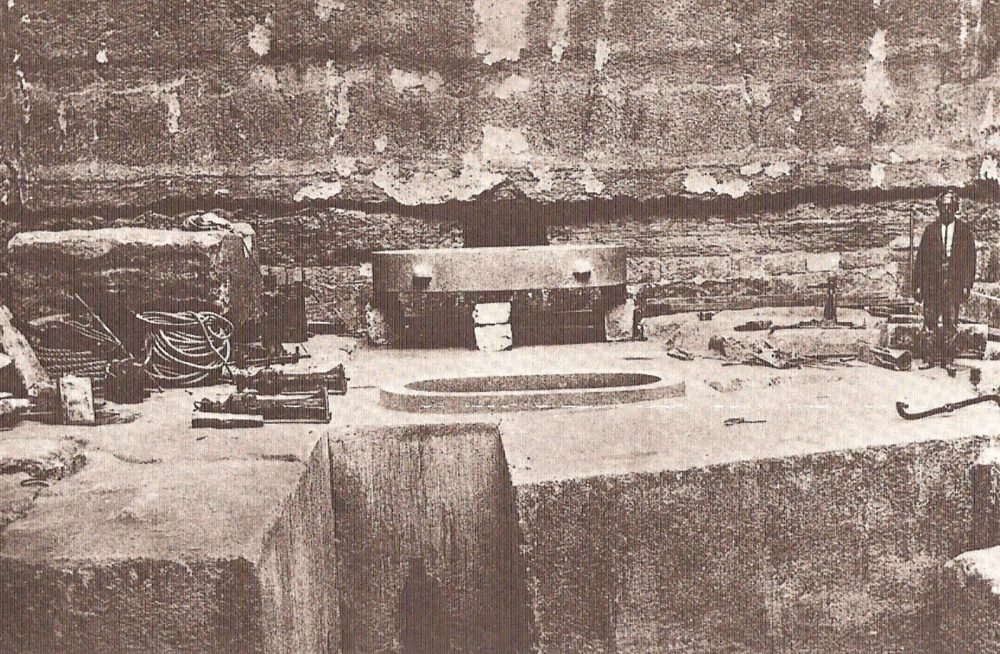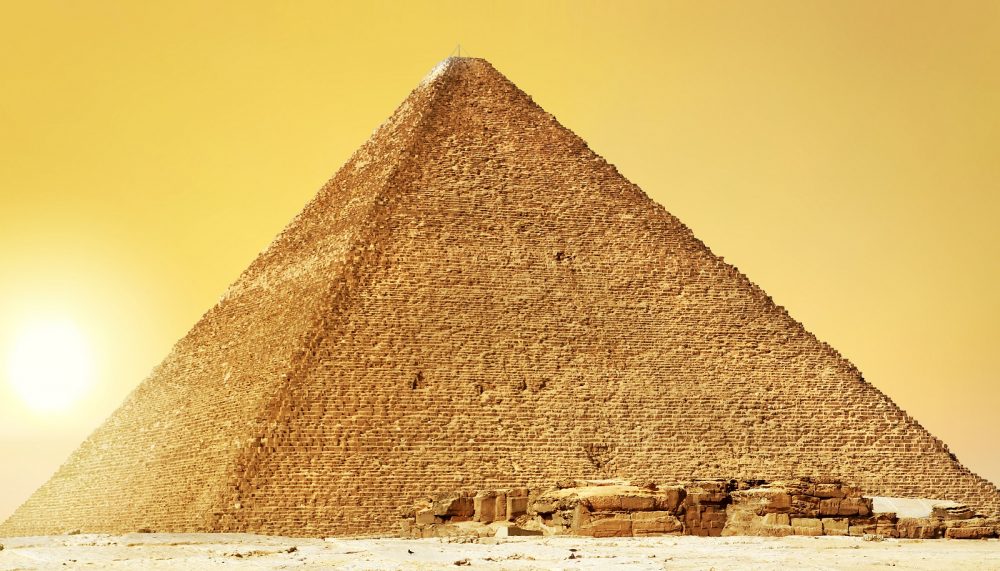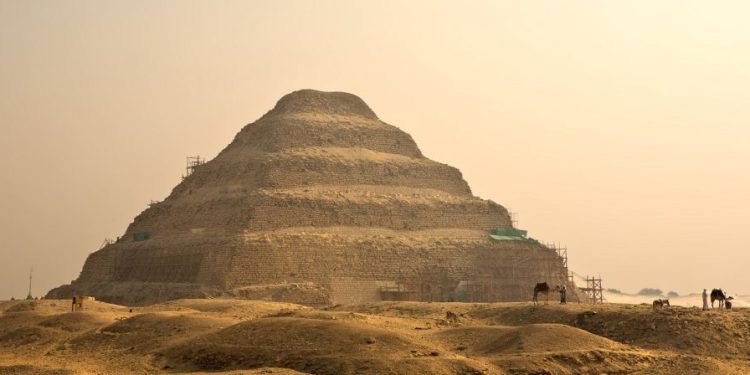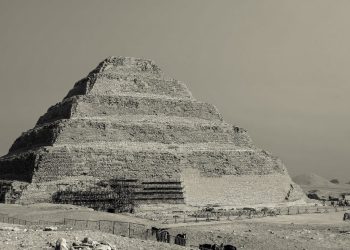The most famous pyramids on Earth, although not the most numerous, are located in modern-day Egypt. The three perhaps most famous pyramids are those that were built at the Giza plateau, supposedly as tombs for the Pharaohs Khufu, Khafre, and Menkaure.
Those three fourth Dynasty pharaohs are thought to have built the most iconic pyramids on the surface of the planet, starting with the Great Pyramid of Giza, some 4,500 years ago, as the eternal resting place for Khufu.
The structure, which is believed to have been built in a twenty-year period was the largest, most extensive construction process the ancient Egyptians ever attempted, marking the peak of the Pyramid Age in Egypt. The Great Pyramid of Giza was an incomparable monument both in terms of size and precision.
But long before the Great Pyramid of Giza was built, the ancient Egyptians constructed other much smaller pyramids.
The first pyramid built in ancient Egypt was that of Pharaoh Djoser, several decades before the completion of the Great Pyramid.
Djoser’s Pyramid was an unpredicted attempt at building a superstructure made of stone.
But the origins of pyramids can be traced back to a time even before Pharaoh Djoser.
Saqqara, mastabas, and the precedents of pyramids
Everything related to the pyramid in Egypt can perhaps be traced back to Saqqara a vast, ancient burial ground in Egypt, serving as the necropolis for the Ancient Egyptian capital, Memphis.
Mastabas, say Egyptologists, most likely played an important role in the later development of stone structures known as pyramids.
Changes in mastaba design from the 1st Dynasty at Saqqara suggest an incipient form of elements of later pyramids, one of the leading pieces of evidence why Egyptologists say they are royal tombs.
Numerous mastabas that were built in Saqqara drew various elements that would later be used in different pyramids.
For example, Mastabas identified by the numbers 3036 and 3035, identified as the tombs of officials Ankhka and Hemaka feature a stepped entrance that was built into the sloping trench that approaches the burial chamber from the East. As noted by Lehner, it is in the very core of Mastabas that features develop which are convincing precedents for later pyramid building.
Mastaba 2185, for example, offers us a unique feature where we see for the first time ancient Egyptians using great stone beams over the burial chambers.
But it is mastaba 3038, built during the reign of Adjub that we find the closest-ever precedent to the step pyramid that Imhotep designed for Pharoh Djoser.
This mastaba was nearly created as a pyramid by accident. The substructure, built into a 4-meter deep rectangular pit was walled with mudbricks rising to a height of six meters. Three of the sides of the mastaba were constructed out to form eight shallow steps that rise towards the sky at an angle of 49 degrees. The mastaba would have resulted in an oblong step pyramid had the builders completed its fourth site, which was left uncovered.

In total, the ancient Saqqara plateau was home to 11 royal pyramids, more than any other site in Egypt. This does not include the satellite pyramids, queens’ pyramids, and Shepsekaf’s mastaba.
The centerpiece of Saqqara, however, is the Pyramid of Horus Netjerikhet, or as he would later be known, Djoser. By the time the step pyramid was being built, the region is already believed to have been considered a royal reserve. Djoser’s pyramid gave it another dimension.
Eventually, pyramid builders left the Saqqara necropolis for almost the entire fourth dynasty of ancient Egypt, as pharaohs would favor Meidum and Dashur during Snferu’s reign, which eventually would lay the foundations for the three pyramids built at the Giza plateau.
By the end of the fourth dynasty of ancient Egypt, around 2,472 BC, Pharaoh Shepseskaf came back ab built a massive stone mastaba in south Saqqara, reverting from pyramid to mastaba building for reasons that remain unclear.
Eventually, Djoser’s Royal Vizier Imhotep would not only design the first-ever pyramid in Egypt but the entire Pyramid complex.
Before Djoser, monumental buildings in Egypt were built using mudbrick and wood.
Then, within Djoser’s 19-year reign, the construction materials were switched, and the builders made use of massive blocks of stone in the buildings.
Imhotep, who amongst his many titles was Chancellor and Great Seer of the Sun god Ra planned designed and completed the massive pyramid enclosure featuring a wall rising towards the sky 10.4 meters and 1,645 meters long. The enclosure was so big that Egyptologists compare Djoser’s Pyramid Complex to the size of a large town in the 3rd millennium BC.
Step Pyramids, rise and fall
The six-tier, four-sided structure built by Djoser was the earliest colossal stone building in Egypt. Its completion marked the rise of pyramids in Egypt. Experts consider the pyramid the earliest large-scale cut stone construction. Djoser’s pyramid complex dominated the Saqqara landscape for millennia, marking a departure from previous architectural styles.
But surprisingly, although the Step pyramid introduced by Imhotep and Djoser was a revolution in the ancient Egyptian architectural sigh, step pyramids did not become “superstars” in the ancient Egyptian architecture.
Many scholars agree that it may have been expected that a long line of comparable step pyramid complexes would follow that of Djoser, but although many other pharaohs borrowed specific design elements, rectangular step pyramid complexes did not endure in ancient Egypt.
That doesn’t mean that no one tired replicating the glorious complex erected by Djoser. The pyramid of Sekhemkhet at Saqqara, just to the south-west of Djoser’s might complex was an attempt to replicate Djoser’s complex.
However, Sekhemkhet’s complex was abandoned soon after it was begun.

After Sekhemkhet, another third-dynasty Pharaoh attempted building a step pyramid complex but failed. Dubbed the Layer Pyramid of Zawiyet el-Aryan, it occupies a site around seven kilometers north of Saqqara, placed on a ridge, although not far from the floodplain. This structure sees a clear departure from the trend set forth by Djoser and Sekhemkhe who built–or tired buildings–their structure far out in the desert.
If the layer pyramid was completed, it would have probably risen five steps to a height of around 42-45 meters. Archeologists discovered no traces of casing stones, probably because the structure was never completed.
The failed attempts to replicate Djoser’s Step pyramid eventually led rise to a series of mysterious pyramids dubbed the Provincial Ste Pyramids.
There are seven such structure known in the provinces, with the southernmost structure located on the island of Elephantine. There, more pyramids were constructed near Ombos, Edfu, and Hierakopolist. Another one is near Abydos. And a solitary pyramid stands in Middle Egypt at Zawiyet el-Meitin. There’s another one that overlooks the Faiyum from atop the desert spur between it and the Nile River.
The exact purpose of these pyramids remains a mystery, although Egyptologists say they were not intended as tombs.
The first “true” pyramids of Ancient Egypt
The history of Step pyramids in Egypt is sudden and abrupt. Just as the stone pyramid appeared all of a sudden with Djoser, it disappeared after numerous failed attempts giving rise to ancient Egypt’s first true pyramids.
Meidum is the most mysterious of all great pyramids built in ancient Egypt. The failed pyramid safeguards the puzzles that transform archaic Egypt into the classic Old Kingdom Pyramid Age, wherein Sneferu played a huge role.
The first king of Manetho’s 4th dynasty is believed to have taken the throne around 2,575 BC. Before Sneferu, it was Djoser’s Pyramid Complex the only one that was completed, and by the time Sneferu took to his throne, it was the only complex standing.
Sneferu would take the throne and take pyramid building to a whole other level, becoming the greatest pyramid-builder in ancient Egyptian history after constructing three massive pyramids: Meidum, Dashur and the smaller, provincial pyramid of Seila.
All three of Sneferu’s pyramids were built with a total mass of stone that exceeds even that of his son and successor Khufu, who is believed to have built the Great Pyramid of Giza.

Sneferu revolutionized pyramid building in ancient Egypt, and pyramids that would follow, like those of Khufu, Khafre and Menkaure brought the pyramid building age to its peak.
At the Giza plateau, the pyramid reached its apogee and standardized features of the Old Kingdom Pyramid complexes were expanded and formalized, resulting in bigger, and more complex temples.
Over three generations, builders would continue constructing major architectural elements at Giza until Djedefre came to the throne and moved construction to Abu Roash.
The last major burial construction at Giza was the tomb of Khentkawes, but it was not a tomb but a mastaba.
Three generations in the Fourth Dynasty of ancient Egypt accomplished the bulk of pyramid building. After the fourth dynasty, the design, size, and complexity of pyramids became less important perhaps reflecting a less centralized society. The gigantic pyramids of Egypt can, therefore, be defined as those which were built over the course of three generations starting with Senefu, Khufu and Khafre.
The pyramids built by Sneferu contain more than 3.5 million cu. meters of stone. This means that all the other pyramids of ancient Egyptian kings, excluding the queens’ and satellite pyramids, contain only 41 percent of the total mass of the pyramids commissioned and built by Sneferu, his successor and son Khufu, and Snefreu’s grandson Khafre.
Pyramid building declined after Menkaure and almost ceased during the Frist Intermediate Period.
Pyramid building was resumed in the Middle Kingdom but never managed to pick up what the fourth dynasty of pyramid builders achieved.
The last ancient Egyptian pyramid was built by Pharaoh Ahmose I. he Pyramid marked the end of the Egyptian Pyramid Building era, and scholars say it was the last pyramid of Egypt, built more than 1,200 years after the Step Pyramid. The pyramid was not intended as a tomb. The pyramid is barely visible today. The monument commissioned by Ahmose I did not survive the harsh conditions it was exposed to in the desert and poor construction work with materials unworthy of a pyramid.











